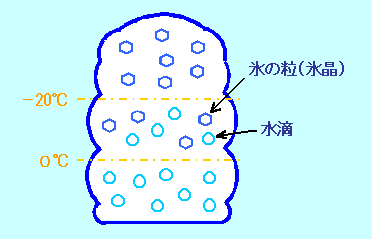week4:Topic is structure of thunder
Why is thunder made?
Although it is clear that it can do in clouds, thunder has not occurred in every cloud. Thunder occurs or does not occur. The base of thunder is static electricity. If a thing rubs, static electricity may occur. When getting off a car on the day which winter dried, clothing and a chair rub, and just before touching a door, it may spark." clouds are the same as this. The particles of clouds rub and static electricity occurs. If it rubs violently, thunder will occur.
The size of raindrops is 0.2 mm. The particles of clouds are diameters and are about 1/100 of that.
And volume is about 1/1 million size. Although the fall is carried out with gravity, since it is small, a drag of air is strong considering the size, and falls very slowly at it. Since the sky is low-temperature, the particles of clouds may be waterdrop, but it may be ice.Since at least 0 ℃ or less does not freeze easily in the air for the surface tension of water, it becomes water drop. However, in the case of about -20 ℃ or less, it is ice generally. In the cumulonimbus of summer, even if there is 30 ℃ near surface of the earth, the sky is very low-temperature. The cumulonimbus top is also -50 ℃. The tops are icy particles although the bottom of clouds is water drop.
And volume is about 1/1 million size. Although the fall is carried out with gravity, since it is small, a drag of air is strong considering the size, and falls very slowly at it. Since the sky is low-temperature, the particles of clouds may be waterdrop, but it may be ice.Since at least 0 ℃ or less does not freeze easily in the air for the surface tension of water, it becomes water drop. However, in the case of about -20 ℃ or less, it is ice generally. In the cumulonimbus of summer, even if there is 30 ℃ near surface of the earth, the sky is very low-temperature. The cumulonimbus top is also -50 ℃. The tops are icy particles although the bottom of clouds is water drop.

It is same that icy particles and frost of a freezer are made. And the water vapor of the air changes to a solid directly.
Since gaseous vapor can be moved quite more
quickly than the water drop of a liquid, vapor adheres to ice rapidly and icy
particles can grow quickly. And it is going to become heavy and is
going to fall.However, when surface of the earth can warm by solar radiation and there is a strong ascending current, it is raised and does not fall easily. While going up in clouds or having fallen, it becomes still larger and becomes large hail. Since the icy particles and hail from which a size is different differ also in in fall velocity, they repeat a collision mutually. "Rubbing" happens then and static electricity occurs. When it collides, an electron is made from one particle. At this time, small particles (cryohydrate) become positive charge, and big particles (hail) become a minus electric charge. Why do big particles become a minus electric charge? It is not solved. Since the big particles are heavier, it moves to the direction under clouds and small particles move to the direction on clouds by an ascending current. Therefore, in the direction under clouds, the electric charge of minus and the electric charges of plus in the direction on clouds gather. Moreover, positive charge is guided with the minus electric charge gathering in a cloud base on the ground. This is called "electrostatic induction."
I was surprised that particles are rubbing in clouds!


0 件のコメント:
コメントを投稿